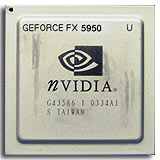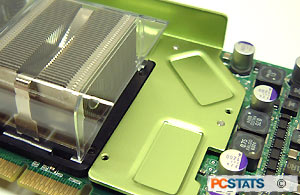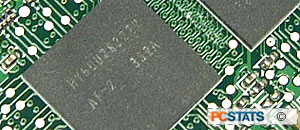
|
We recently got the chance to take
a look at Nvidia's latest graphics processor release, the FX5950 Ultra chip, as thoughtfully provided by
Gigabyte in their GV-N595U video card.
82% Rating: 
|
|
|
|
Home >
Reviews >
Video Cards >
Gigabyte GV-N595U |
|
|
The Nvidia FX5950 Ultra GPU
 The FX5950 is the current flagship of
Nvidia's newest graphics processor
line. Succeeding the FX5900 and FX5900 Ultra, it is Nvidia's current 'high end' offering
intended for gaming and benchmark enthusiasts. The FX5950 is the current flagship of
Nvidia's newest graphics processor
line. Succeeding the FX5900 and FX5900 Ultra, it is Nvidia's current 'high end' offering
intended for gaming and benchmark enthusiasts.
The GPU itself is identical to the FX5900, with the core and
memory rates increased to 475Mhz and 950Mhz respectively
(a jump of 25Mhz for the core and 100Mhz for the memory over
the 'ultra' version). This gives it an effective bandwidth of 30GB per second as
opposed to the 5900 Ultra's 27.2GB/s.
Like the Ultra, the FX5950 comes equipped with an impressive 256MB of
DDR RAM. The FX5950 also sports a brand new cooling solution which moves away from
the traditional 'fan-on-heatsink-on-GPU' design seen in most videocards.
Instead, Nvidia has instituted a sort of wind tunnel design, with the fan
drawing cool air from outside the case through the tunnel and over the enclosed
heatsink, then out into the case.
 Rather logical when you think about
it, as opposed to cooling the GPU with the already heated internal air of the
case. I suspect however that this reference design won't be adopted by many
manufacturers in the long run. Because the card takes up two
full slots in the PC, there is bound to be some grumbling from consumers on
the matter. Rather logical when you think about
it, as opposed to cooling the GPU with the already heated internal air of the
case. I suspect however that this reference design won't be adopted by many
manufacturers in the long run. Because the card takes up two
full slots in the PC, there is bound to be some grumbling from consumers on
the matter.
Like its
FX5900 cousin, the 5950 uses thermal throttling to reduce the speed (and noise)
of the fan when the card is not being heavily used. Thermal sensors are also
used as a safeguard to prevent the core from being damaged by excessive heat, as
the card will slow itself down to prevent this, similar to the failsafe measure
present in Intel's Pentium 4 line of processors.
The
Gigabyte GV-N595U's cooling solution is what attracts the most immediate
attention. It looks like Gigabyte essentially bolted one of those old PCI bay exhaust
fans on top of the hefty aluminum heat sink covering the GPU.
Of course,
in this case, the fan sucks cool air in from outside the case and blows it over
the heatsink, then vents the heated air into the case. The memory chips on the front and back of the card
are passively cooled by a pair of large green anodized aluminum plates.
 Once the card is plugged in and
running through benchmarks, the air being vented into the case is quite toasty warm,
as is the front ramsink, which under load was too hot to touch.
The rear ramsink remained merely warm
however. This is unsurprising as it appears to have considerably more surface area. Once the card is plugged in and
running through benchmarks, the air being vented into the case is quite toasty warm,
as is the front ramsink, which under load was too hot to touch.
The rear ramsink remained merely warm
however. This is unsurprising as it appears to have considerably more surface area.
A laser
thermal sensor used on both heatsinks directly above the memory chips gave reading of 36 degrees for
the front and 45 degrees for the back, which seems odd at first glance,
since as we stated, the front heatsink is noticeably hotter to the touch.
Considering
the increased surface area of the rear heatsink though, it is likely that the
majority of the heat generated by the memory, and possibly some of the residual
heat from the core (since the rear sink covers the area of the card behind the
GPU also) is being handled by it. It's worth noting that the
rear ramsink design has changed considerably from the original reference card, which had a
design similar to the one seen on the front ramsink. Heat problems perhaps?
|
